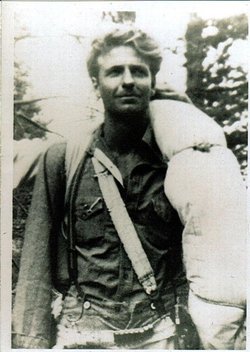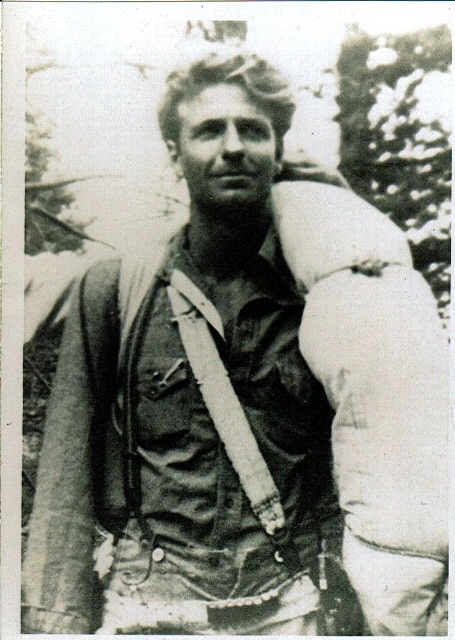Durand was born in Missouri in 1913. His family moved to Wyoming in 1918. He completed the 8th grade, then traveled by horseback south toward Mexico. He was arrested for suspicion of vagrancy in Saguache County, Colorado, and again in New Mexico. Both times, he was released without charges. He was often absent from the Powell area for weeks at a time. He is said to have crossed the Mojave Desert in 1932. Reportedly, he told a friend he would have died crossing the desert if he had not killed a wildcat and eaten it raw.
Durand had a reputation locally an expert marksman, trapper, and poacher. He is said to have given the meat to poor families in the area. On March 14, 1939, he was arrested for poaching a bull elk, fined $100 and sentenced to 60 days in jail. While Durand was in jail, a local rancher filed a complaint against him for poaching one of the rancher's calves. If convicted, Durand faced a maximum sentence of two years.
News of the pending charges seems to have spurred the idea Durand needed to escape jail. While he was being served a meal on March 16, he scuffled with Deputy Noah Riley, hit the deputy over the head with a milk bottle, and forced the deputy to drive him to the home of a family friend, then to his parents' home. Law enforcement officials surrounded the house. During a brief gun battle, Durand killed two of the officers, Chuck Lewis and D. M. Baker, then escaped the house into the surrounding countryside.
The murders spurred a manhunt. Because of his survivalist skills, Durand was able to evade capture. On March 22, searchers located Durand in an inaccessible hideout at Beartooth Mountain. Two of them, Emil Argento and Orville Linabary, attempted to rush Durand's position. Durand shot and killed both of them.
Eventually, Durand pretended to join the hunt himself. He caught a ride back to town with one of the searchers, who didn't recognize him. For reasons that are not clear, Durand then attempted to rob the First National Bank. Reportedly, he got about two thousand dollars in cash, then for an unknown reason began firing his gun.
Hearing the gunfire, local citizens gathered around the bank, and shots were fired into the bank. Attempting to escape, Durand pushed three men out of the bank in front of himself: Bob Nelson, the bank president; Maurice Knutson, a vice president; and John Gawthrop, a bank clerk. Gawthrop was killed in the gunfire. Durand himself was wounded by a shot fired from across the street by 17-year-old Tipton Cox. Durand crawled back into the bank. The coroner's inquest later found that Gawthrop was killed by an unknown person in the crowd, and that Durand himself, once back inside the bank, shot himself in the head. The finding has been disputed by others who say Durand was killed by those who then rushed the bank.
Earl Durand's story inspired two romanticized accounts: a ballad, "Ballad of Earl Durand" (Charlie Brown, 1967) and a movie, "The Legend of Earl Durand" (starring Peter Haskell as Earl Durand, 1974). He is also the subject of a book "The Last Eleven Days of Earl Durand" by Jerred Metz (2005).
Biography by Justin Durand
Durand was born in Missouri in 1913. His family moved to Wyoming in 1918. He completed the 8th grade, then traveled by horseback south toward Mexico. He was arrested for suspicion of vagrancy in Saguache County, Colorado, and again in New Mexico. Both times, he was released without charges. He was often absent from the Powell area for weeks at a time. He is said to have crossed the Mojave Desert in 1932. Reportedly, he told a friend he would have died crossing the desert if he had not killed a wildcat and eaten it raw.
Durand had a reputation locally an expert marksman, trapper, and poacher. He is said to have given the meat to poor families in the area. On March 14, 1939, he was arrested for poaching a bull elk, fined $100 and sentenced to 60 days in jail. While Durand was in jail, a local rancher filed a complaint against him for poaching one of the rancher's calves. If convicted, Durand faced a maximum sentence of two years.
News of the pending charges seems to have spurred the idea Durand needed to escape jail. While he was being served a meal on March 16, he scuffled with Deputy Noah Riley, hit the deputy over the head with a milk bottle, and forced the deputy to drive him to the home of a family friend, then to his parents' home. Law enforcement officials surrounded the house. During a brief gun battle, Durand killed two of the officers, Chuck Lewis and D. M. Baker, then escaped the house into the surrounding countryside.
The murders spurred a manhunt. Because of his survivalist skills, Durand was able to evade capture. On March 22, searchers located Durand in an inaccessible hideout at Beartooth Mountain. Two of them, Emil Argento and Orville Linabary, attempted to rush Durand's position. Durand shot and killed both of them.
Eventually, Durand pretended to join the hunt himself. He caught a ride back to town with one of the searchers, who didn't recognize him. For reasons that are not clear, Durand then attempted to rob the First National Bank. Reportedly, he got about two thousand dollars in cash, then for an unknown reason began firing his gun.
Hearing the gunfire, local citizens gathered around the bank, and shots were fired into the bank. Attempting to escape, Durand pushed three men out of the bank in front of himself: Bob Nelson, the bank president; Maurice Knutson, a vice president; and John Gawthrop, a bank clerk. Gawthrop was killed in the gunfire. Durand himself was wounded by a shot fired from across the street by 17-year-old Tipton Cox. Durand crawled back into the bank. The coroner's inquest later found that Gawthrop was killed by an unknown person in the crowd, and that Durand himself, once back inside the bank, shot himself in the head. The finding has been disputed by others who say Durand was killed by those who then rushed the bank.
Earl Durand's story inspired two romanticized accounts: a ballad, "Ballad of Earl Durand" (Charlie Brown, 1967) and a movie, "The Legend of Earl Durand" (starring Peter Haskell as Earl Durand, 1974). He is also the subject of a book "The Last Eleven Days of Earl Durand" by Jerred Metz (2005).
Biography by Justin Durand










